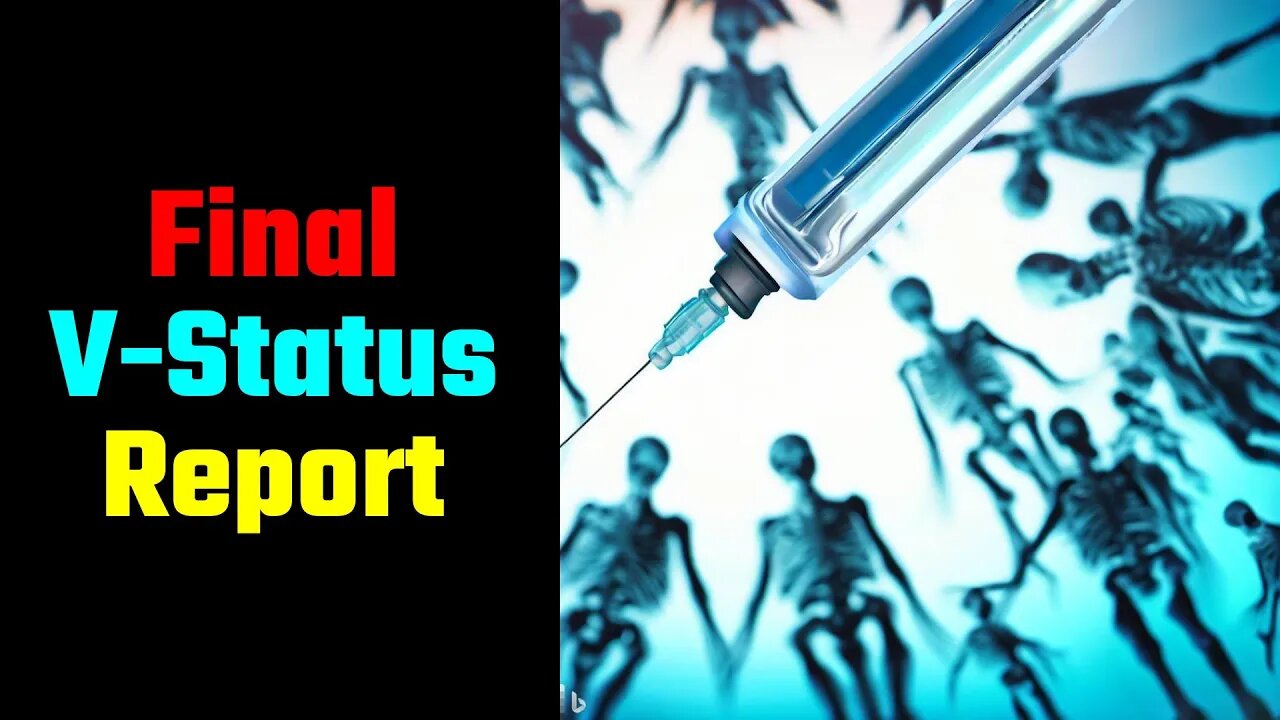Premium Only Content

The Final V-Status Report UK
We take a look at the final report ever from the Office for National Statistics website out of the UK, “Deaths involving [something] by v-status, England: between 1 April 2021 and 31 May 2023”. I apologise, I have to watch what I say, because I often get into trouble just by mentioning these things. This data shows the age-standardised mortality rates, meaning it is directly comparable, but please note I cannot offer my interpretation, I can only show you the data and you can interpret it how you will.
This is actually their final report ever! If you click on Corrections and Notices, and scroll down to the notice dated 25 August, “We will no longer be updating the Deaths by v-status analysis, England series. The last edition was published on 25 August 2023. This publication was created during the [something] to answer important questions around mortality by v-status in a timely manner.” So yes, this is it. At least they published a lot more information than the Australian Government ever did.
We’re interested in number 2. Deaths by v-status, and we’ll be clicking on this link here to grab all the data.
So this is what the data looks like, but to make it easier to understand, I’ll create some charts for us.
This chart shows the Monthly Age-Standardised Mortality Rates (ASMR) per 100,000 from 2021 to May 2023 for all-cause mortality, so traffic accidents, diseases, everything. The dark blue line represents the mortality of those who did not take any V. We’ll call them our control group. There’s not much to say until we add more data.
This is the mortality rate of those who took a single dose only at least 21 days ago. As I said, I’m not here to interpret the data, I can only say that this cohort of people have a higher overall mortality than the control group, noting that there can be confounding factors. Just as one example, people who took a single dose may have been older on average and in worse health than the control group, although, that’s just speculation on my part, and not verifiable in this data. The point is, there can be confounding factors. This data also shows that the mortality rate started off quite high in 2021, and has steadily dropped off since then.
The line in yellow shows the mortality rate of those who took two doses only at least six months ago. You can see that in mid-2021, recipients had significantly better mortality than the control group, but this quickly disappeared as time progressed and became significantly worse by 2022. As with the other groups, the mortality rate has significantly fallen since then, although recipients continue to have higher all-cause mortality than the control group, remembering there could be confounding factors.
Shown in green is the all-cause mortality for those who took three and only three doses at least 21 days ago. You can see at the beginning towards the end of 2021, they had significantly better mortality than the control group, but that quickly wore off and became worse than the control group, although this difference is only slight in recent months.
The last dose they have data on is the fourth dose shown in brown. These are people who took a fourth dose at least 21 days ago. Their all-cause mortality seems to be either the same or worse than the control group, remembering there could be confounding factors such as age and ill-health.
Some of you might be asking, “What about people who took their last dose less than 21 days ago?”. Well they do have data for that, so let’s take a look. Let’s just clear the graph except for the control group.
The red line shows the mortality rate of those who took a single dose less than 21 days ago, at that time of course. As expected, there’s less data due to the small 21-day window, but clearly mortality went up as time progressed.
Those that took a second dose less than 21 days ago also follow a somewhat similar pattern. Their mortality stays around the same as the control group, and then spikes.
For those who took a third dose, within 21 days, mortality started off relatively low, but increased over time. There seems to be a pattern here.
Similarly with those who took a fourth dose less than 21 days ago, although the spike in mortality doesn’t go much higher than the control group in this case.
Anyway, that’s the UK data for all-cause mortality based on v-status. Remembering, that will be the last time they publish this data ever again. So now we won’t know what the hell is going on, probably exactly how they like it.
OFFICE OF NATIONAL STATISTICS – DEATHS BY V-STATUS, ENGLAND
https://www.ons.gov.uk/peoplepopulationandcommunity/birthsdeathsandmarriages/deaths
MUSIC
Allégro by Emmit Fenn
-
 6:02
6:02
Daily Insight
11 months agoPublic Transport Network Wokified in Australia’s Capital
1832 -
 LIVE
LIVE
The Rabble Wrangler
7 hours agoRedSec with Mrs. Movies | The Best in the West Carries His Wife to Victory!
228 watching -
 23:42
23:42
Robbi On The Record
2 days ago $5.31 earnedWhat's happening in the republican party?? BTS of Michael Carbonara for Congress
43.7K8 -
 4:53
4:53
PistonPop-TV
2 days ago $0.02 earnedThe G13B: The Tiny Suzuki Engine That Revved Like Crazy
16 -
 LIVE
LIVE
GritsGG
3 hours ago#1 Most Warzone Wins 4000+!
278 watching -
 LIVE
LIVE
Joker Effect
1 hour agoSTREAMER NEWS: WHAT IS JOKER DOING?! Where is the streamer space going now?! Q & A
233 watching -
 LIVE
LIVE
Eternal_Spartan
3 hours ago🟢 Eternal Spartan Plays Arc Raiders - New Updates! | USMC Veteran
96 watching -
 LIVE
LIVE
CODZombieGod115
8 hours ago $0.04 earned🟢 Live - Ashes Of The Damned Round 100 Attemp or Easter Egg Attempt! Black ops 7 Zombies
32 watching -
 2:03:49
2:03:49
Mally_Mouse
1 day ago🔥🍺Spicy HYDRATE Saturday!🍺🔥-- Let's Play: Cuff Bust
37.7K2 -
 2:06:12
2:06:12
SavageJayGatsby
10 hours ago🔥🌶 Spicy Saturday – Cuff Bust Chaos! 🌶 🔥
27.8K